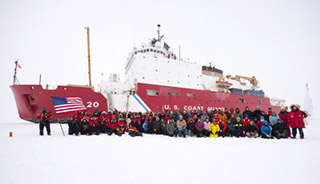When the U.S. Coast Guard Cutter Healy, homeported in Seattle, arrived at the North Pole on Sept. 5, she became the first U.S. surface ship to do so unaccompanied. Her mission marks only the fourth time that a U.S. surface vessel has ever reached the North Pole, and the first since 2005.
Healy’s crew and science party, totaling 145 people, departed Dutch Harbor, Alaska, Aug. 9, in support of GEOTRACES, an international effort to study the geochemistry of the world’s oceans. This National Science Foundation-funded expedition is studying the Arctic Ocean in an effort to create baseline measurements of the air, ice, snow, seawater, meltwater and ocean bottom sediment for future comparisons.
The U.S. is an Arctic nation and the Coast Guard has operated in the Arctic since the 1860s. Reaching the North Pole serves as a testament to the Coast Guard’s continued ability to provide access and presence throughout this increasingly important and operationally challenging region of the world. Last week, President Obama called to expedite the building of Coast Guard icebreakers in an effort to enhance the Coast Guard’s Arctic capabilities.
The Healy, delivered in 1999 by Huntington Inglls, is the nation's newest high-latitude vessel. A 420-foot, 16,000-ton, 30,000-hp icebreaker, she is capable of breaking more than 10 feet of ice. In addition to performing the Coast Guard’s other statutory missions such as law enforcement and search and rescue, Healy is a research platform with extensive laboratory spaces, multiple oceanographic deck winches, and berthing for 50 scientists.
As the Arctic region continues to open up to development, the data gathered onboard Healy during this research cruise will be used to better understand the Arctic guide stewardship over the region.





